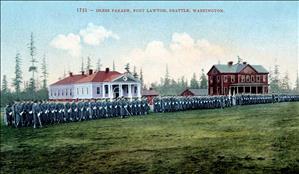On February 9, 1900, the U.S. Army designates the military installation on Magnolia Bluff as Fort Lawton. It becomes part of the system of defenses protecting Puget Sound from naval attack. The fort is named after Major General Henry Ware Lawton (1843-1899), a veteran of the Civil War and the Treaty Wars, who was killed in action in the Philippines. The site of Fort Lawton will remain in military hands until 1970, when it is turned over to the City of Seattle and becomes Discovery Park.
Naval Defenses
In 1891, U.S. Senator John B. Allen (1845-1903) won a fight with Congressional representatives from California and Oregon to establish a Navy yard on Puget Sound. Port Orchard Bay was selected for what would become the Puget Sound Naval Shipyard at Bremerton. Military planners considered defense of the area a high priority for the reasons that:
- enemy vessels might easily harbor in Puget Sound;
- the growing commercial centers of Seattle, Everett, and Tacoma could become targets;
- plans were in place to build a ship canal from Shilshole Bay to Lake Union large enough to accommodate warships.
By 1894, 11 sites for fortifications were identified, including Magnolia Bluff, which offered a good defensive position and close proximity to land and sea transportation. In 1895, U.S. Senator Watson C. Squire (1838-1926) coordinated an appropriation to build a regimental post there, but Secretary of War Lamont included the provision that the property be acquired without cost to the U.S. Government. The Seattle Chamber of Commerce launched a canvass of donations of land and cash and in February 1898 turned over to the U.S. Army title to 703 acres. Construction of buildings and roads began in June 1898. The first soldiers arrived in December 1899.
Originally planned as a fortification, the first Coast Artillery unit did not arrive at Fort Lawton until July 1901, and guns were installed only temporarily. Fort Worden and Fort Flagler near Port Townsend on the Olympic Peninsula and Fort Casey on Whidbey Island were built for heavy guns as the first and second lines of defense, and Fort Lawton would be the third line of defense. In May 1902, the Fort became an Infantry post and although it was designed to accommodate a full regiment (approximately 3,500 men), it rarely saw more than a headquarters and one battalion. In 1927, the fort was converted to a Corps of Engineers installation.
Fort Lawton never assumed the size and economic importance expected by boosters in Seattle. Pierce County received the benefits of the much larger Camp Lewis, built just before World War I. In 1938, the Army offered the entire property of Fort Lawton to the City of Seattle as a park for the cost of one dollar. The City Council declined because it was unsure whether the City could bear the cost of maintenance.
On the eve of World War II, Fort Lawton became part of the Port of Embarkation, San Francisco, supporting the movement of troops overseas through Seattle. As many as 20,000 troops were staged there at a time and a total of 1.1 million troops passed through the installation during and after the war. Some 1,150 German prisoners of war were housed there (some are buried in the cemetery), and 5,000 Italian prisoners of war passed through on their way to confinement in Hawaii. After World War II, Fort Lawton was used as an Air Force radar site, a surface-to-air Nike missile site, and a training center.

